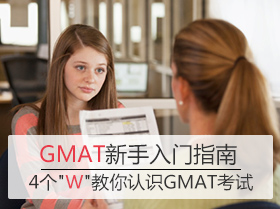GMAT阅读高频模考题型解题思路实例精讲:整体质量管理理论介绍
- 2020年03月23日13:32 来源:小站整理
- 参与(0) 阅读(3994)
GMAT阅读部分的难度一直都被认为比较高,特别是一些高频题型常会让缺乏解题思路和技巧的考生觉得头疼。下面小编就结合实例讲解GMAT阅读中的经典高频拟真难题思路技巧,帮助大家提升阅读得分效率和解题速度。
今日练习题为阅读题,题目如下
文章:
According to P. F. Drucker, the management philosophy known as Total Quality Management (TQM), which is designed to be adopted consistently throughout an organization and to improve customer service by using sampling theory to reduce the variability of a product's quality, can work successfully in conjunction with two older management systems. As Drucker notes, TQM's scientific approach is consistent with the statistical sampling techniques of the "rationalist" school of scientific management, and the organizational structure associated with TQM is consistent with the social and psychological emphases of the "human relations" school of management.
However, TQM cannot simply be grafted onto these systems or onto certain other non-TQM management systems. Although, as Drucker contends, TQM shares with such systems the ultimate objective of increasing profitability, TQM requires fundamentally different strategies. While the other management systems referred to use upper management decision-making and employee specialization to maximize shareholder profits over the short term, TQM envisions the interests of employees, shareholders, and customers as convergent. For example, lower prices not only benefit consumers but also enhance an organization's competitive edge and ensure its continuance, thus benefiting employees and owners. TQM's emphasis on shared interests is reflected in the decentralized decision-making, integrated production activity, and lateral structure of organizations that achieve the benefits of TQM.
1. The primary purpose of the passage is to
A point out contradictions in a new management system
B compare and contrast the objectives of various management systems
C identify the organizational features shared by various management systems
D explain the relationship of a particular management system to certain other management systems
E explain the advantages of a particular management system over certain other management systems
正确答案:
D
2. Which of the following best describes the relationship of the second paragraph to the first paragraph?
A It presents contrasting explanations for a phenomenon presented in the first paragraph.
B It discusses an exception to a general principle outlined in the first paragraph.
C It provides information that qualifies a claim presented in the first paragraph.
D It presents an example that strengthens a claim presented in the first paragraph.
E It presents an alternative approach to solving a problem discussed in the first paragraph.
正确答案:
C
3. According to the passage, the rationalist and human relations schools of management are alike in that they
A are primarily interested in increasing profits
B place little emphasis on issues of organizational structure
C use statistical sampling techniques to increase profitability
D are unlikely to lower prices in order to increase profitability
E focus chiefly on setting and attaining long-term objectives
正确答案:
A
文章分析:
TQM可以成功的和2个比较老的管理系统结合---但是简单的嫁接是不行的---为什么不行----TQM需要根本上不同的策略
这篇文章结构十分鲜明,主旨也就相对比较明确。
题目详解:
第一题
题目释义:主旨题目
考点:主旨(Main idea)
旨在考察我们对文章整体的把握程度,对文章的结构的分析能力和把控能力,以及对作者逻辑的判断。
这篇文章讲的是,TQM可以和两种系统结合,他们的大体目标相同,但是又有根本上的区别。总体来说可以认为文章讲了TQM与其它管理系统的关系。
选项分析:
(A) 指出新的管理系统自相矛盾的地方。文中,TQM本身这个管理系统没有问题。如果说有矛盾的话,应该是和其他管理系统的结合上有矛盾(可以结合却不能简单的嫁接)。
(B) 比较和对比各种管理系统的目标。作者在文中提到,这些系统的目标都是相同的。定位在“TQM shares with such systems the ultimate objective of increasing profitability”
(C) 识别各种管理系统的组织特点。作者只提到了TQM的组织特点和以前的一种管理系统相似。并没有详细的解释这些组织特点。
(D) Correct. 解释一个特定的系统与其它管理系统的关系。在考点中解释过了,此处不再赘述。
(E) 解释一个特定的管理系统比之于其它系统的优点。其实作者并没有表现出自己的对于某种管理系统的偏爱,所以也谈不上优缺点之说。
第二题
题目释义:细节题目
考点:逻辑结构(Logical structure)
旨在考察我们对文章结构的认知,以及对作者行文目的的判断。
第二段开头就出现“however”,说明第二段和第一段存在一定的反对或是限定关系。从原文中来看,第一段说TQM可以有效的与其它系统结合,第二段说不能简单的嫁接。所以第二段可以认为是对第一段提出的这个概念的一个限定。
选项分析:
(A) 它提出了关于第一段描述的现象的截然不同的解释。第二段不是对TQM的完全不同的解读,而是对第一段说的比较宽泛的范围进行的一个较小的限定。
(B) 它讨论了第一段突出的普遍的原则的一个例外。这个选项较易误选。注意,第一段的如果是一个普遍的原则的话,第二段并没有论证这个原则是不适用于某些地方的,而说它是有条件的适用的。
(C) Correct. 它提出限定第一段的论点的信息。同“考点”的解释。
(D) 它提出了一个加强第一段提到的论点的例子。第二段的没有加强第一段的论点,相反的,可以理解为削弱第一段的论点。
(E) 它提出了对第一段所讨论的问题的令一种探讨。第二段所讲述的问题并不是一种全新的理解。而是在现有的基础上做限制。
第三题
题目释义:细节题目
考点:支持主题(Supporting ideas)
旨在考察我们对文章细节的认知
从题设来看,我们要把定位定在第二段。因为第一段只说了TQM和这两个“老”管理系统分别的相同之处。题目问的是两个老管理系统之间的相同之处。
选项分析:
(A) Correct. 都主要对增加利润感兴趣。原文定位在第二段“TQM shares with such systems the ultimate objective of increasing profitability”。几乎为原文的摘抄。
(B) 不重视组织结构的问题。原文最后一句话“TQM's emphasis on shared interests is reflected in the decentralized decision-making, integrated production activity, and lateral structure of organizations that achieve the benefits of TQM.”提到的是TQM重视组织结构,但是我们无从得知题目中这两个老管理系统是否也重视组织结构。
(C) 用数据抽样技术来增加利益。从原文第一段我们只能看出“the rationalist”是用这种方式的,无从得知"human relations"是否也用这样的技术。
(D) 不太可能降价来增加利润。这个选项有一定迷惑性。文章中确实只在说TQM时才提到了降价促销。但是没有任何证据表明题目中的两个老管理系统不用降价这个策略来增加利润。
(E) 总体上注意设立和获得长期目标。这个选项定位在“While the other management systems referred to use upper management decision-making and employee specialization to maximize shareholder profits over the short term, TQM envisions the interests of employees, shareholders, and customers as convergent. ”这句话说明题目中这两种管理系统都比较重视短期目标,而不是长期目标。
以上就是GMAT阅读高频模考题型解题思路实例精讲,希望能为大家提供一些参考帮助。





























